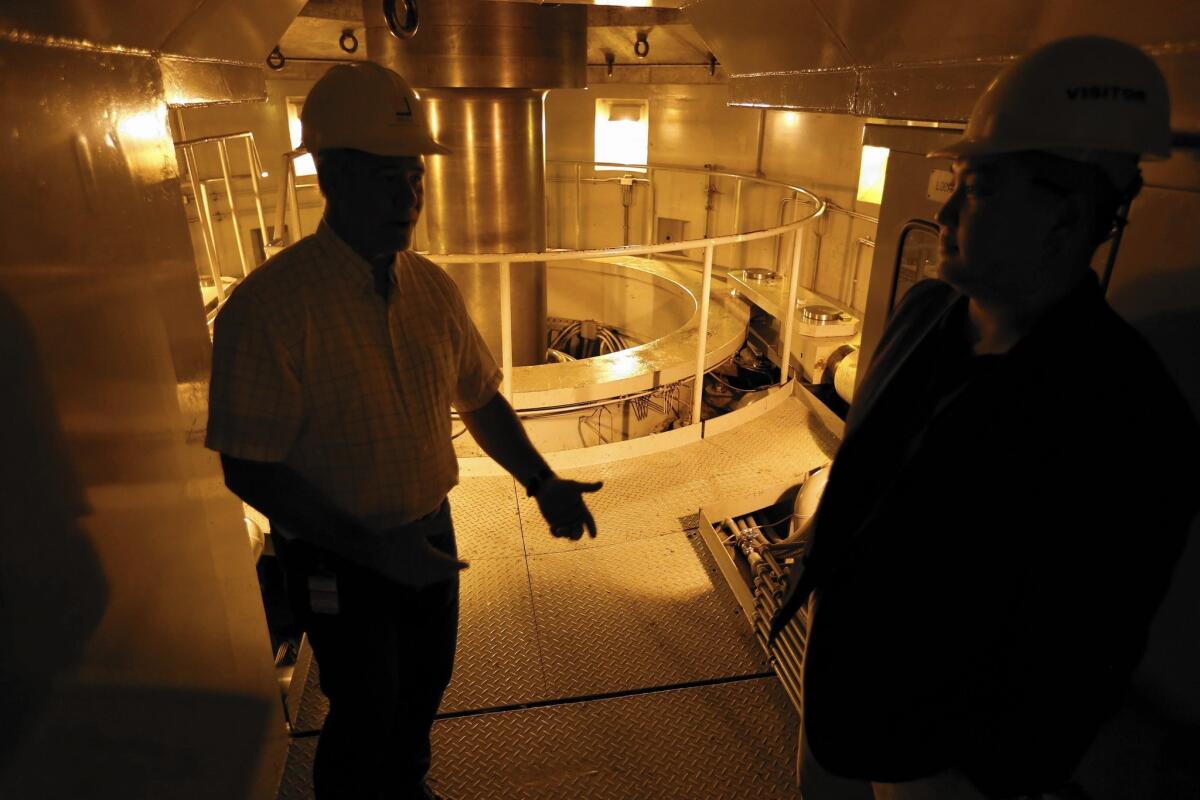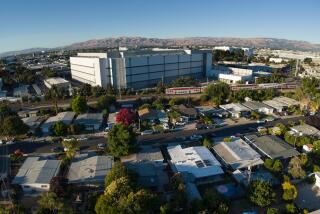How Edison uses water to store excess power

- Share via
BIG CREEK, Calif. — Nestled high in the Sierra mountains among the pine and fir trees, a little-known man-made wonder may help resolve a pressing energy concern: how to store wind and sun power that the grid increasingly can’t handle.
For nearly three decades, water has flowed down from the mountains’ artificial lakes to spin an electricity generator at the John S. Eastwood Power Station, the crown jewel of Southern California Edison’s Big Creek hydroelectric system.
The underground powerhouse — sheltered in a cavern blasted from granite bedrock — has produced cheap and reliable electricity. And when windmills, solar panels and other sources generated more power than Californians needed, the excess electricity would spin the generator in reverse to pump the water back up the mountain to a reservoir to hold for later; called “pump storage,” it’s a way of stockpiling electricity.
Then four years of relentless drought took its toll.
This year, for the first time, Southern California Edison probably will get no electricity out of its prized Eastwood facility. The water has fallen so low at a key source, Shaver Lake, that giant granite boulders are visible along the shoreline.
“The last three or four years are probably the worst I’ve seen in my life,” said 60-year-old Joel Preheim, Edison’s production manager at Big Creek, who first moved to this town the locals call the “Camp” when he was 3.
The Eastwood pump station’s idleness comes at a tricky time.
Solar and wind power production is exploding as the state pushes ambitious renewable energy goals. To help manage and store that electricity — created only when the sun shines and the wind blows — California energy officials have begun studying large-scale pump operations, according to a letter sent to regulators last month by the head of the agency that handles long-distance transmission for most of the state.
Water and Power is The Times’ guide to the drought. Sign up to get the free newsletter >>
The entire energy industry is racing to unlock the mysteries of affordable energy storage. Billionaire Elon Musk is investing heavily in developing better batteries. Others are looking at unusual approaches, including using solar energy to produce hydrogen gas, which can be saved for when its needed. Some hope to rely on the kind of hydro pump storage provided by Eastwood.
State regulators in October 2013 set a target for utilities to bring 1,325 megawatts of new storage online by 2024. It would take more than six times Eastwood’s 200 megawatts of hydro storage to meet that goal.
“The vast majority of existing electricity storage is pumped hydro,” said Lucas Davis, an economics professor at UC Berkeley.
“But it makes me nervous when we start talking about hydro being needed,” Davis said. “During drought years, that’s a killer.”
NEWSLETTER: Get the day’s top headlines from Times Editor Davan Maharaj >>
Eastwood and its eight sister hydropower plants at the Big Creek system have been an important part of Edison’s shrinking electricity generation fleet. (The other units produce electricity but don’t provide storage.)
Buried 1,000 feet in granite rock, Eastwood is an engineering marvel, built in these mountains from 1983 to 1987, about a 90-minute drive east of Fresno. Some 89 Edison employees keep the Big Creek system running in this town of 200 residents.
The heart of the $277-million Eastwood power plant lies behind a towering security gate. The trip down a long cave to the turbine that spins 200 feet beneath Shaver Lake feels like a scene from “Journey to the Center of the Earth.”
At the end of the trip is the generator, surrounded by a trough where water flows, causing the turbine to spin. The ability to recycle water through the pump station is what has made it such an attractive concept.
“That’s the nice thing about hydro,” Preheim said. “You can use it over and over and over.”
Edison began to draw water to feed the first of Big Creek’s nine power houses about 100 years ago. The first power lines — then the world’s longest — reached Los Angeles from Big Creek in 1913.
“Most technologies don’t last 100 years,” Preheim said.
At one time, Big Creek served as Edison’s third-largest source of electricity generation, behind the San Onofre nuclear plant and Mohave coal power station. Big Creek has outlived them both.
Now, second to Edison’s 1,054-megawatt Mountainview natural gas plant, Big Creek accounts for 5% of the utility’s electricity generation.
Unlike natural gas and nuclear plants, Eastwood and other hydro facilities can ramp up in as little as six minutes.
“Hydro is a very important resource,” said Andrew McMillan, Big Creek’s manager of dispatch operations. “We’re a life boat.”
But hydro is vulnerable to the vagaries of mother nature.
“The water level,” McMillan said of Big Creek’s lakes, “is down 33.7 feet.”
That adds another wrinkle to the complexity of a state electricity system that already is facing unprecedented change. State regulators were warned in late July that managing wind and solar power will soon get much more complicated.
The warning came from Steve Berberich, chief executive of the California Independent System Operator Corp., which is responsible for making sure that supply and demand are always perfectly balanced on the transmission system serving about 80% of the state.
At times, solar and wind create excess generation that Berberich’s office must figure out how to manage. Just as insufficient electricity causes problems — power reductions and blackouts — too many electrons can damage the power grid and anything connected to it.
“Energy storage, with its unique ability to both consume excess renewable energy, and to quickly inject clean energy back onto the grid to meet ramping and peak demand needs, has the potential to be a cornerstone of the new electric network,” Berberich wrote to the California Public Utilities Commission.
But capturing, and later releasing, extra electricity in large amounts at an affordable price requires technology that is still being developed. The fact that pump storage already exists makes it an attractive option when water is plentiful, leading Berberich to alert the utility regulators that his operation will be studying the benefits of deploying pump storage on a large scale.
When too much electricity is being produced, “we just can’t turn resources on and off to fix the oversupply,” said Steven Greenlee, a spokesman for the California Independent System Operator, which doesn’t own the power sources.
The first tool currently available is to find electricity generators to submit bids to reduce their output, Greenlee said. If that doesn’t work, then there’s an effort to export the electricity elsewhere — often at negative prices, which means power generators pay someone to take their electricity.
In an emergency, the system operator has authority to order any power source to cease production and disconnect from the grid.
“But this is a last resort and not something we want to do,” Greenlee said.
The preference is to capture the excess generation. The urgency to do so is growing with more utility-scale wind and solar projects coming online and with more homeowners and businesses setting up rooftop solar installations.
In spring 2014, Berberich’s office recorded four instances in which solar and wind generation had to be cut, for a total of about six hours, because too much power was produced. The combined reduction was more than 1,700 megawatts.
In such cases, Berberich sees pump storage facilities such as Eastwood as helping prevent loss of the excess electricity.
But relying on hydro storage as a significant part of the answer concerns some experts such as Davis, the UC Berkeley professor. He said the drought has shown that hydro needs serious review, as do other energy storage methods when it comes to cost and efficiency.
“I don’t think we know yet,” Davis said of the focus on hydro storage, “if this is good public policy or not.”
Twitter: @ivanlpenn
MORE:
Backers of desalination hope Carlsbad plant will disarm critics
In Navajo country, coal gives life — and takes it, some say
Look up drought report cards for California’s urban water districts
More to Read
Inside the business of entertainment
The Wide Shot brings you news, analysis and insights on everything from streaming wars to production — and what it all means for the future.
You may occasionally receive promotional content from the Los Angeles Times.











